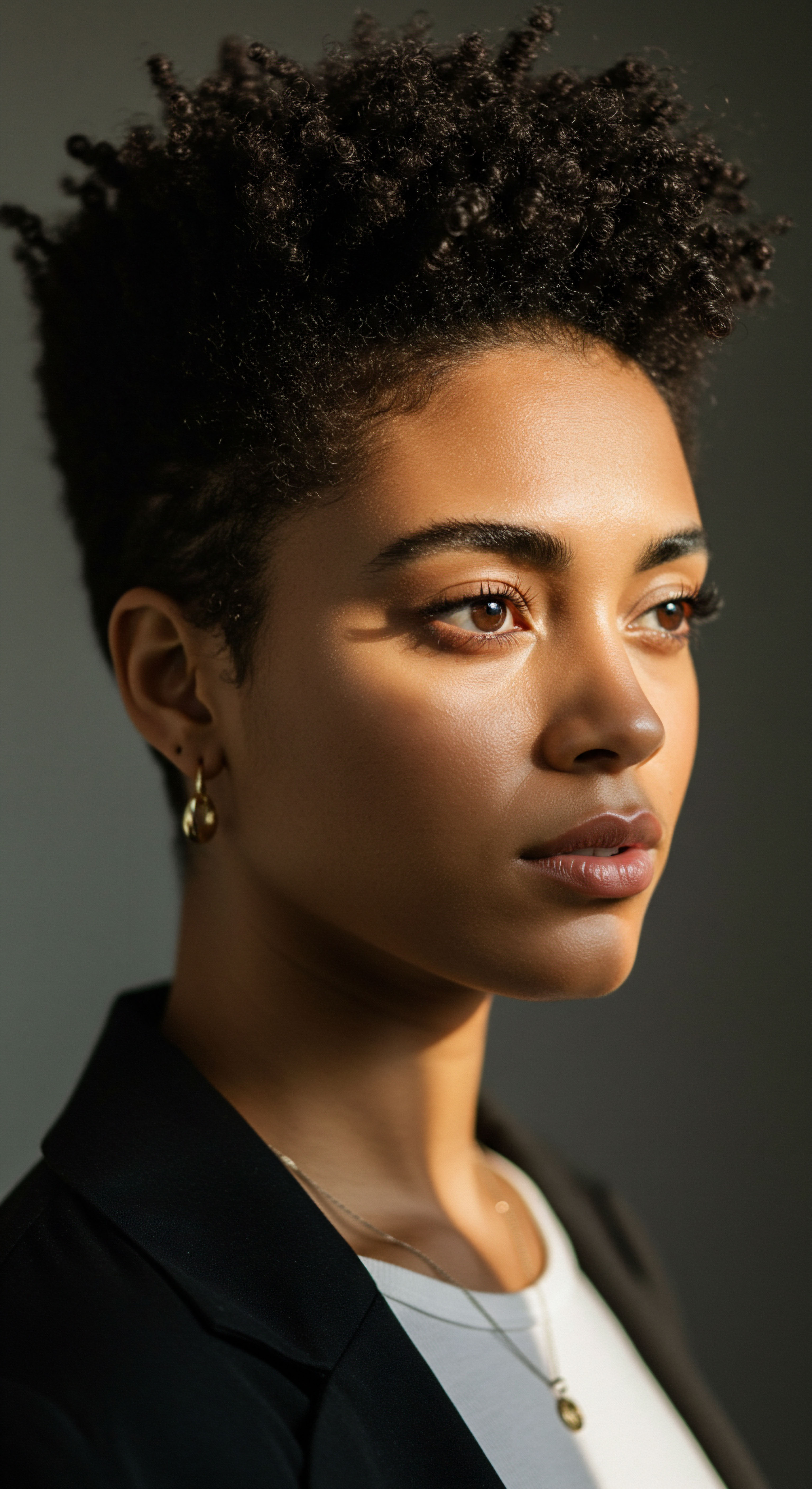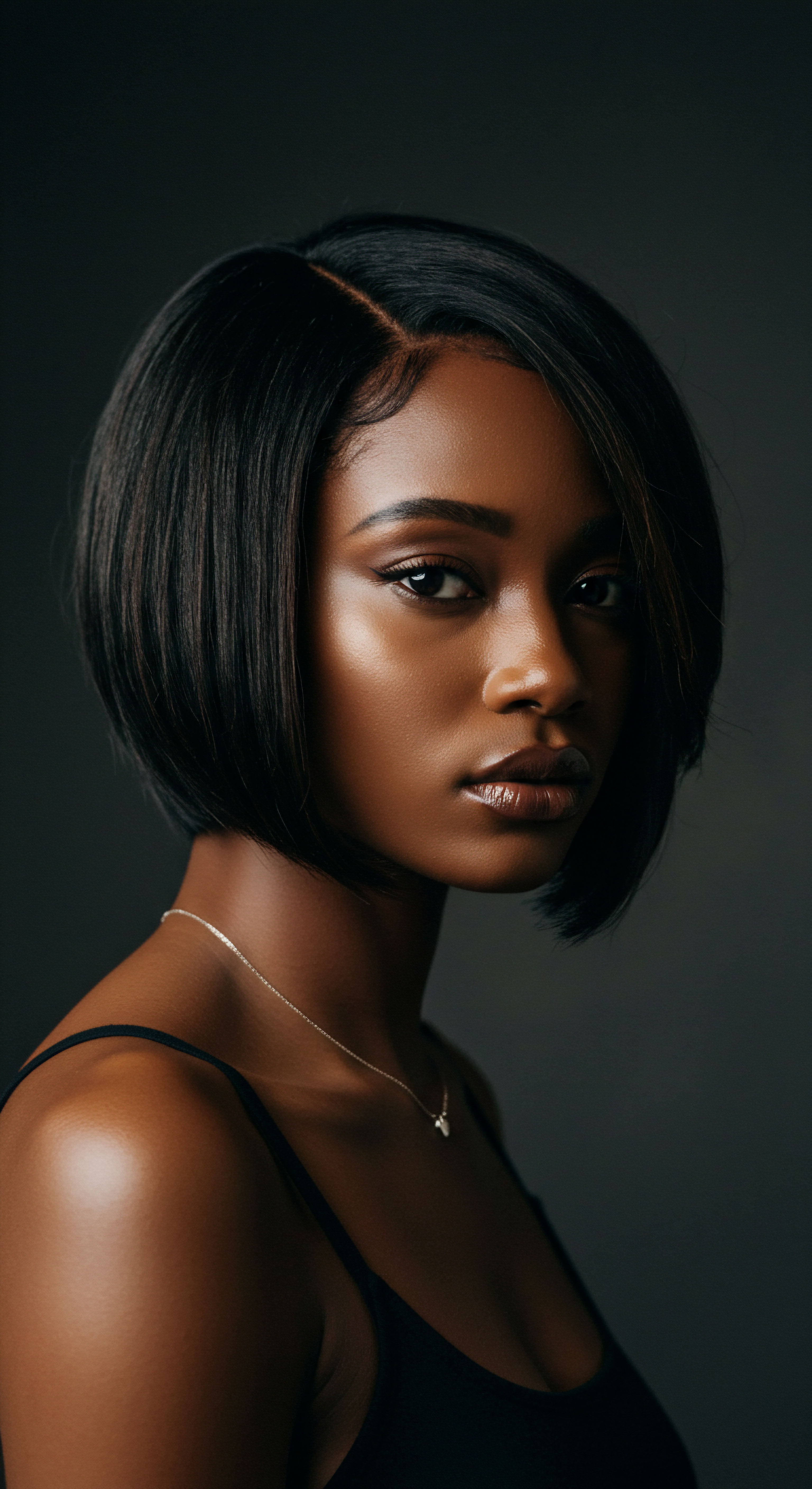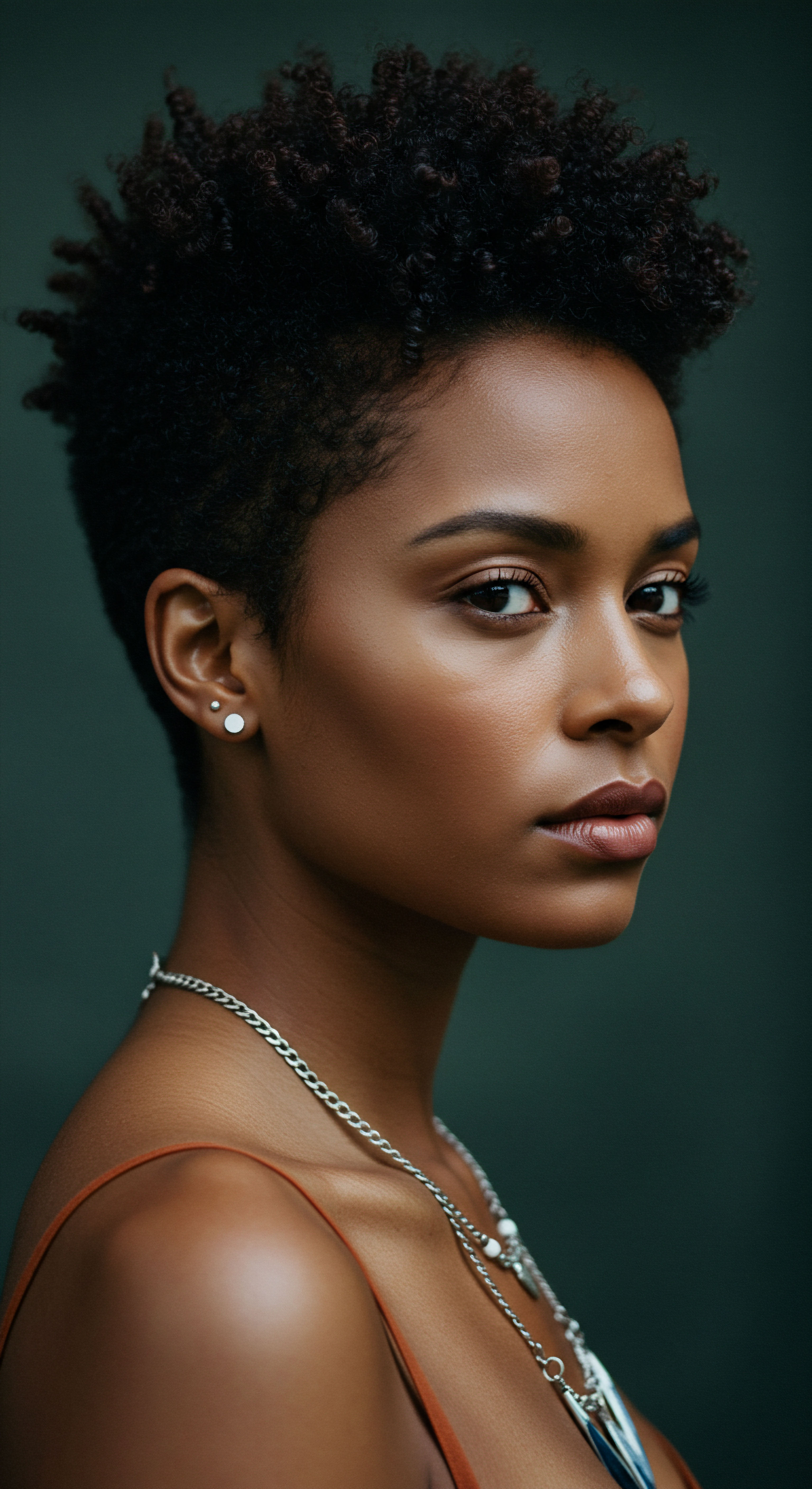
Roots
Consider for a moment the quiet hours of night, when the world outside softens its edges, and we surrender to the rhythm of sleep. Within this calm, a subtle dance takes place, one that deeply shapes the well-being of our hair. This nightly interaction, often unseen and unconsidered, holds profound implications for every strand, particularly those with a delightful coil or curl.
Our exploration begins at the very surface of hair, with its protective outer layer ❉ the cuticle. Understanding this delicate shield is paramount to comprehending how sleep friction influences hair’s vitality.
The cuticle, a marvel of biological engineering, comprises overlapping scales, much like shingles on a roof. These scales, made of keratinized cells, typically lie flat, creating a smooth surface that reflects light, contributing to hair’s natural sheen, and acting as a barrier against external aggressors. The integrity of this outer layer is a primary determinant of hair health, its ability to retain moisture, and its resilience against mechanical stressors.
When these scales are tightly closed and smooth, hair feels soft and resists damage. Conversely, when they lift or become compromised, hair can feel rough, appear dull, and become vulnerable to breakage.

What Constitutes the Hair Cuticle’s Surface?
The outermost boundary of each hair fiber is not merely a collection of scales; it is a sophisticated system designed for protection and interaction with its surroundings. Atop these keratin scales lies a very thin, lipid-based coating, known as the F-layer or 18-methyleicosanoic acid (18-MEA) layer. This natural fatty acid renders virgin hair hydrophobic, meaning it repels water.
It helps maintain the hair’s smoothness, aids in reducing surface friction, and safeguards against excessive moisture absorption or protein loss. When this F-layer remains undisturbed, water beads on the hair surface, and products are absorbed more slowly, a characteristic often associated with low porosity hair.
However, this protective F-layer is susceptible to disruption. Chemical processes, such as bleaching, coloring, or relaxing treatments, can strip this vital coating away. Mechanical stressors, including vigorous brushing, rough towel drying, or constant rubbing against abrasive surfaces, also degrade this layer.
Once the F-layer is compromised, the hair surface becomes more hydrophilic, attracting water readily, even if the underlying cuticle structure remains largely intact. This alteration can lead to hair behaving as if it possesses high porosity, absorbing moisture quickly but losing it just as fast, leaving it feeling dry and susceptible to frizz.
The hair cuticle, a layered shield, governs a strand’s well-being and its response to environmental interactions.

How Does Cuticle Alignment Affect Hair’s Behavior?
The way these cuticle scales lie—or do not lie—determines much of hair’s tactile and visual characteristics, as well as its propensity for damage. When the cuticle scales are aligned and smooth, hair fibers glide past one another with minimal resistance. This contributes to the feeling of softness and allows for easier detangling. The light reflects uniformly from such a surface, enhancing shine.
- Low Porosity Hair ❉ Typically has tightly packed, flat cuticle scales. This structure makes it more challenging for moisture to enter the hair shaft, but once inside, moisture is retained very well. Such hair often appears shiny and resists wetting.
- Medium Porosity Hair ❉ Possesses cuticle scales that are slightly raised but remain flexible. This allows for a balanced absorption and retention of moisture and products. It is generally considered healthy and adaptable.
- High Porosity Hair ❉ Characterized by raised, chipped, or even missing cuticle sections. This structure allows moisture to enter rapidly but also to escape with equal speed, leading to dryness, frizz, and an increased susceptibility to breakage. This condition often results from external damage rather than being an inherent genetic trait.
The mechanical properties of hair, including its resistance to friction, are intrinsically tied to the state of its cuticle. A compromised cuticle surface increases the friction between individual hair strands and between hair and other materials. This elevated friction, in turn, can exacerbate cuticle damage, creating a cyclical process where weakening surfaces lead to more friction, which causes further abrasion.

Ritual
As the day recedes and evening descends, our routines shift, preparing us for restorative sleep. For our hair, this transition offers both opportunity and vulnerability. The gentle wisdom passed down through generations, often rooted in practical observations, guides many in caring for their textured strands during these nocturnal hours.
Yet, beyond tradition, a scientific lens reveals precisely how our nightly practices, or their absence, interact with the hair cuticle, determining the degree of friction it experiences and, consequently, its condition come morning. This section considers the purposeful actions that shield hair during rest, transforming the sleep period from a time of potential damage into a sanctuary for strands.
Sleep friction, the mechanical rubbing of hair against surfaces like pillowcases, presents a significant challenge to the cuticle’s integrity. As we shift and turn during the night, our hair is constantly pressed and dragged across the pillow. This continuous rubbing can cause the delicate cuticle scales to lift, fray, and even break, leading to tangible consequences such as frizz, tangles, split ends, and overall weakening of the hair shaft.

How Do Pillowcase Materials Influence Hair Condition?
The choice of pillowcase material plays a surprisingly significant role in mediating sleep friction. Common cotton pillowcases, despite their widespread use, can be particularly detrimental to hair. The fibers of cotton are naturally absorbent and possess a rougher texture at a microscopic level, even when the fabric feels soft to the touch. This inherent roughness creates considerable friction against hair strands.
When hair, especially textured hair with its inherent bends and coils, rubs against cotton, the cuticle scales are agitated and roughened. This not only leads to physical damage but also absorbs moisture from the hair, leaving it drier and more prone to frizz and breakage. A study published in the Journal of Cosmetic Dermatology reported that smoother fabrics, such as silk, can reduce hair friction by up to 43% compared to cotton.
Selecting appropriate sleep surfaces can dramatically reduce hair’s exposure to nightly abrasive forces.
In contrast, silk pillowcases offer a dramatically smoother surface. Silk fibers are long, smooth, and tightly packed, allowing hair to glide effortlessly across the surface with minimal resistance. This reduced friction helps to maintain the cuticle scales in their flat, aligned position, thereby preserving the hair’s natural oils and moisture.
The result is often less tangling, reduced frizz, and fewer split ends upon waking. Satin, a synthetic alternative with a similar smooth texture, offers comparable benefits at a more accessible price point.
| Material Type Cotton |
| Surface Texture Rough, fibrous |
| Moisture Absorption High |
| Friction Level High |
| Typical Hair Outcome Frizz, tangles, dryness, breakage |
| Material Type Silk |
| Surface Texture Smooth, tightly woven |
| Moisture Absorption Low |
| Friction Level Low |
| Typical Hair Outcome Reduced frizz, maintained moisture, less breakage |
| Material Type Satin |
| Surface Texture Smooth (synthetic) |
| Moisture Absorption Low |
| Friction Level Low |
| Typical Hair Outcome Reduced frizz, maintained moisture, less breakage |
| Material Type Smooth surfaces provide a gentler sleep environment for hair, minimizing cuticle disturbance. |

What Protective Styles Guard Hair While Sleeping?
Beyond the pillowcase, the way hair is prepared for sleep holds significant sway over its well-being. Protective hairstyles are not merely aesthetic choices; they are functional strategies to minimize mechanical stress and preserve the hair’s structure overnight. By securing hair in a contained manner, these styles reduce its movement and direct contact with abrasive surfaces, thereby mitigating friction and tangling.
A loose braid, for example, keeps hair strands aligned and prevents them from rubbing against each other or the pillow. This simple method can significantly reduce morning tangles and breakage. Similarly, a low bun, secured with a soft scrunchie rather than a tight elastic, offers a compact way to keep hair off the neck and contained.
For textured hair, bonnets and silk scarves represent traditional and highly effective methods of protection. These coverings create a smooth, low-friction barrier between the hair and the pillow, effectively shielding the cuticle from mechanical abrasion. They also aid in retaining the hair’s natural oils and applied moisture, which is especially beneficial for hair types prone to dryness.
- Loose Braids ❉ Keep hair strands aligned, reducing inter-strand friction and tangling against the pillow.
- Low Buns ❉ Contain hair in a compact shape, minimizing contact with surfaces and preventing widespread tangles.
- Silk or Satin Bonnets/Scarves ❉ Form a smooth, protective layer around the hair, drastically cutting down on friction and preserving moisture.
These practices, whether passed down through generations or discovered through personal experimentation, collectively form a nighttime ritual that respects the delicate nature of the hair cuticle, ensuring it remains as smooth and resilient as possible.

Relay
Stepping beyond the immediate touch and feel of hair, we arrive at a deeper consideration ❉ how does the cumulative effect of nightly interactions truly reshape the hair’s enduring vitality? This inquiry takes us into the subtle mechanics of friction, the particularities of hair morphology across different ethnic groups, and the long-term consequences of consistent cuticle disruption. It is a space where scientific rigor meets the lived reality of textured hair, revealing a complex interplay of forces that extends beyond surface-level observations.
The physical act of sleeping, with its inevitable tossing and turning, subjects hair to repetitive mechanical stress. This constant movement against a surface generates friction, a force that opposes motion and can lead to the erosion of the hair’s outermost layer. The coefficient of friction, a scientific measure of this resistance, becomes a telling indicator of potential damage.
Research into hair tribology, the study of friction, lubrication, and wear, highlights that the cuticle’s scale-like structure inherently possesses a higher friction coefficient compared to a perfectly smooth surface. This characteristic, while providing some protective interlocking, also makes hair vulnerable to abrasion when repeatedly rubbed against external materials.

How Does Hair Morphology Influence Frictional Damage?
The unique structural properties of different hair types significantly influence their susceptibility to sleep friction. African hair, with its characteristic elliptical cross-section and tightly curled structure, presents a distinct challenge. This curl pattern means that individual hair strands frequently coil around each other, creating numerous points of contact and increasing hair-on-hair friction. When this inherent self-friction combines with external friction from a pillowcase, the potential for cuticle damage is amplified.
A compelling study highlighted this distinction ❉ African hair exhibits a higher friction coefficient when sliding against fibrous textiles like cotton, compared to Asian hair. This higher friction, coupled with the observation that African hair generally possesses lower mechanical properties in terms of ultimate strength and strain to failure, suggests a greater propensity for damage and breakage under mechanical stress. This is not a judgment of strength, but an observation of structural differences that necessitate specific care strategies.
Hair’s structural variations, particularly curl patterns, dictate its susceptibility to frictional wear during sleep.
The consequence of this heightened friction is not merely cosmetic. Repeated mechanical wear can cause the cuticle scales to lift, chip, and eventually degrade, exposing the inner cortex of the hair fiber to further harm. This degradation accelerates moisture loss, reduces shine, and ultimately leads to increased breakage and split ends.
Consider the cumulative effect ❉ if an average person moves their head approximately 40 times per night, and each movement involves friction between hair and a typical pillow, this amounts to around 14,600 friction cycles annually. For individuals with hair types that inherently generate higher friction, such as tightly coiled textures, this constant abrasion can lead to accelerated cuticle erosion over months and years, making hair chronically dry, frizzy, and prone to breakage.

Can Nighttime Habits Lead to Traction Alopecia?
Beyond generalized cuticle damage, the sustained tension from certain nighttime hair practices can lead to a specific form of hair loss known as traction alopecia. This condition results from prolonged or repetitive pulling on hair follicles. While commonly associated with tight hairstyles worn during the day, recent research has begun to shed light on “nocturnal traction” as a contributing factor.
Patients with afro-textured or curly hair often employ various techniques to preserve their hairstyles overnight, aiming to reduce the time and expense associated with daily restyling. These methods, while practical for style maintenance, can sometimes inadvertently apply continuous tension to the hair roots. For instance, tight braids, locs, weaves, or extensions that are kept in for extended periods and then pulled up or twisted for sleep can exert constant force on the scalp.
The implications of this sustained pulling are concerning. Hair follicles were not designed to withstand such continuous tension, especially when supporting the added weight of extensions or intricate styles. Symptoms of intolerance can range from discomfort and pain, particularly when the head rests on a pillow, to headaches, sleep disruption, and, critically, hair shaft epilation, which can cause balding areas on the scalp.
A 2021 study on nocturnal traction highlights that while many protective styles are beneficial, the way they are secured or maintained overnight can pose a risk. For example, if hair extensions are attached with hard lumps near the scalp, involuntary movements during sleep can cause these lumps to pull on natural hair shafts, leading to epilation. The study emphasizes the importance of asking patients about their nighttime hair practices to identify at-risk individuals and provide appropriate counseling to prevent permanent hair loss.
| Practice Sleeping on Cotton |
| Mechanism of Impact Rough surface, high friction, moisture absorption |
| Potential Hair Outcome Frizz, tangles, dryness, breakage, cuticle lifting |
| Practice Sleeping with Wet Hair |
| Mechanism of Impact Cuticle swelling, increased friction, fragility |
| Potential Hair Outcome Fraying, tangles, breakage, split ends |
| Practice Tight Nighttime Styles |
| Mechanism of Impact Constant tension on follicles, reduced blood flow |
| Potential Hair Outcome Traction alopecia, discomfort, hair loss |
| Practice Involuntary Head Movements |
| Mechanism of Impact Repetitive rubbing against surfaces |
| Potential Hair Outcome Cumulative cuticle damage, dullness, breakage |
| Practice Conscious choices and gentle habits can mitigate nightly hair damage. |
The scientific understanding of hair’s mechanical properties, coupled with an awareness of cultural hair practices, paints a more complete picture of sleep friction’s impact. It is a reminder that hair care extends beyond waking hours, demanding consideration for how our strands are protected even as we rest.

Reflection
As the quiet of night descends, our hair, too, enters a phase of interaction with its environment. The cuticle, that often-overlooked outer layer, stands as the primary point of contact, its integrity silently shaped by the forces of sleep friction. We have traversed the foundational aspects of its structure, observed its response to nightly rituals, and delved into the scientific and cultural depths of its long-term preservation.
The journey into understanding hair’s cuticle and its nocturnal encounters reminds us that beauty is not merely about outward appearance; it is deeply rooted in intrinsic health and respectful practices. Every gentle gesture, every conscious choice of material, contributes to a story of care that unfolds while we sleep. What quiet habits might you cultivate to honor the resilience of your hair, allowing its true vibrancy to shine through each morning?

References
- Chevalier, N. R. (2017). Hair-on-hair static friction coefficient can be determined by tying a knot. Colloids and Surfaces B ❉ Biointerfaces, 159, 924–928.
- DOC Japan株式会社. (2024, September 16). Understanding Hair Porosity ❉ Causes and Solutions.
- EKB Journal Management System. (n.d.). Friction Coefficient and Electric Static Charge of Head Scarf Textiles.
- Lab Muffin Beauty Science. (2020, October 18). Silk for Skincare and Haircare.
- Lofton, T. (2023, May 1). How One Patient’s Textured Hair Nearly Kept Her From a Needed EEG. Sleep Review.
- Mulberry Park Silks. (2025, May 19). Key to ‘long, flowing’ locks laid bare as experts laud simple upgrade as ‘foundation for hair growth’. GB News.
- ResearchGate. (2021, February 19). Nocturnal Traction ❉ Techniques Used for Hair Style Maintenance while Sleeping May Be a Risk Factor for Traction Alopecia.
- ResearchGate. (2022, June 25). Physicochemical Properties of Textured Hair.
- Rest. (n.d.). Ditch Cotton Pillowcases | Best Pillow Cases for Better Skin and Hair.
- scooms. (2024, April 22). Are silk pillowcases good for hair?
- Silkie. (n.d.). The Link Between Sleep Position and Hair Damage ❉ What You Need to Know.
- The Trichological Society. (n.d.). Hair Extensions Hair Loss.
- TRI Princeton. (2023, December 4). The Fabric Factor ❉ The Role of Your Pillowcase and Hair Accessories in Hair Care.